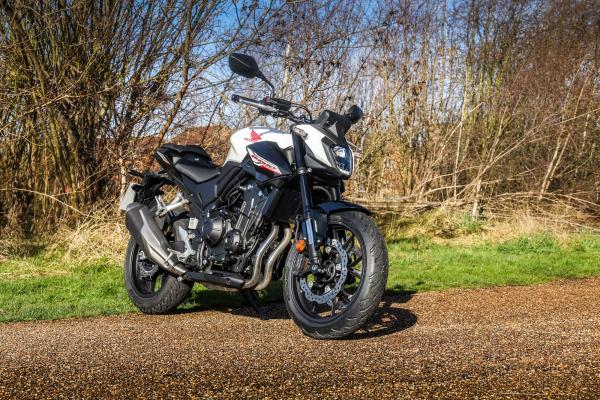
The CB500F has been rebranded as a Hornet and brought with it some useful changes
Suddenly, the launch of the Honda CB750 Hornet last year needs to be looked at in a whole new light. It wasn’t Honda bringing back a name from its back catalogue for a single bike, but as shown at EICMA 2023, a whole new family of machines under one banner.
Except ‘new’ doesn’t describe all of them. Yes, the CB750 Hornet is a completely fresh bike and the CB1000 uses a new frame (albeit housing an old engine), but the CB500 Hornet is much more familiar. Check out the side profile, and you’ll likely recognise it: yep, it’s merely a CB500F with a name change and some light styling tweaks. An Alan Partridge quote springs to mind.
So, is the bike any more appealing now it is - in Honda’s words - part of the ‘hive’? We tested one on a variety of UK roads over the course of a week to find out.
Honda CB500 Hornet price and availability
The CB500 Hornet is available to order now for £6,199. According to Honda’s 9.9 per cent APR PCP example on the site at the time of writing, you can put £1,320.69 down as a deposit followed by 36 monthly payments of £79.
The colour options are limited, consisting of Matte Gunpowder Black Metallic, Pearl Himalayas White, or Grand Prix Red. It's a shame, as the old CB500F looked great in Pearl Dusk Yellow which was added in 2022.
How is the CB500 Hornet different from a CB500F?
Thankfully, the bike’s changes go beyond a revised colour palette the new stickers slapped on the side ducts, which, by the way, are far less subtle than the Hornet branding found on the CB750 and CB1000, almost like the CB500 is compensating for its lower displacement.
The stickers we’re not so keen on, but the nose cone and headlight unit, which brings the CB500 more in line with the CB750, is more successful. To our eyes, it looks like an improvement on the CB500F’s front end.
Perhaps the most significant change is the new five-inch colour TFT, shared with the NX500 (another rebrand - that used to be the CB500X), the CBR500R, CB650R and CBR650R. The old LCD was starting to look pretty old hat and wasn’t always the easiest thing to read - particularly in bright conditions - so the new display is a very welcome addition. It includes Honda RoadSync, so you can connect your phone via Bluetooth, enabling turn-by-turn navigation.
The ECU has been tweaked, altering the ignition time for better acceleration from the 471cc parallel twin. The engine is otherwise unchanged - it still has a conventional 180-degree crankshaft (the CB750 Hornet uses a 270-degree crank for an offset firing order), and makes 46.2bhp, bang on the limit for A2 licenses. Peak power arrives at 8600rpm, while peak torque of 31.7lb ft is felt from 6,500rpm.
The final addition is Honda Selectable Torque Control (or traction control, as everyone else calls it), which can easily be switched on via a press and hold of a button on the left-hand switchcube.
The rest of the bike is all the same as before, benefitting from most of the changes brought about by the CB500F’s 2022 facelift, including the switching from a single front brake disc to a pair of rotors, squeezed by four-piston Nissin callipers, a Showa Separate Function Big Piston upside-down fork with 41mm stanchions, tweaked rear monoshock settings and a lighter swingarm.
What’s it like to ride?
Funnily enough, the CB500 Hornet rides much like a CB500F. That said, the parallel-twin seems more eager than I remember it being previously - that could be down to the ECU tweaks, or merely because this is an engine that can surprise.
You fire it up and get that typical 180-degree twin ‘sewing machine’ audio at idle and low revs, or as I like to call it, ‘the soundtrack of direct access’. Crank it right around to the 8,600rpm redline, though, and the 471cc unit reveals a surprisingly fruity, punchy-sounding top-end.
Being A2 compliant out of the box, the CB500 Hornet had no chance of being a rocketship, but a very respectable kerb weight of 188kg means it still feels reasonably quick. Upshifts are a little more leisurely, as there’s no optional quickshifter here, but the six-speed gearbox itself shifts smoothly and doesn’t give any reason for grumbling.
The low-ish weight also makes for an agile-feeling bike that’ll happily change direction quickly and with little fuss, made to feel snappier still thanks to the use of a reasonably narrow 160/60/17 rear tyre.
That skinnier rear hoop does rob a little confidence in higher-speed cornering, but the slight reduction in stability is paid off in terms of agility on tight, twisty roads, and also during low-speed manoeuvring. It’s no wonder this bike’s predecessor is so popular with riding schools, and that’ll no doubt remain the same with this Hornet-branded version.
You’re never going to get particularly sophisticated suspension at this kind of price, but in any case, the CB500 Hornet strikes a good balance between comfort and composure. It’s only when you get to a particularly undulating road and higher speeds that the chassis starts to feel overwhelmed as it awkwardly moves through its travel. However, at lower speeds when you’re going over speed bumps and negotiating potholes you haven’t been able to avoid, the suspension soaks things up commendably.
Speaking of low-speed bimbling, it’s worth noting the throttle isn’t always the smoothest during such riding, although it’s a far cry from the noticeably snatchy electronic throttle on the CB750 Hornet.
The CB500F gaining an extra disc for 2022 is still very much appreciated here, with the Nissin-based setup offering plenty of stopping power, although they’re not the easiest to modulate.
The five-inch colour TFT is a big step up from what came before. It’s far clearer and presents all the key information in an easy-to-read way. The menu system is straightforward, too. Connecting to the Honda RoadSync app was easy and went through first time. I was able to send a text message (dictated by voice) via the system successfully, but we did get an error message whenever trying to navigate to a destination, which was frustrating but could have been a quirk with the particular Android phone we’ve used.
Perhaps where the bike shone brightest was in terms of fuel economy - during our testing we averaged around 65mpg, despite a heavy bias towards country road riding with plenty of explorations of the parallel twin’s top end. This isn’t surprising - I tested a CB500F for a couple of months a few years ago and the MPG was consistently high. I even managed to get over 90mpg on one trip.
CB500 Hornet Vs CB750 Hornet
When looking at Honda’s current line-up, it’s hard not to look at the £1,100 gap between the CB500 Hornet and the CB750 (below) and wonder if it’s worth spending the extra.
The bikes might now look quite similar and have the same chassis hardware, but there are plenty of differences. The CB750 gets a different frame and bodywork, and, of course, a much larger and more powerful engine. It displaces 755cc and produces 90bhp at 9,500rpm and 55lb ft of torque at 7,250rpm.
The extra power isn’t the draw of the CB750, though - it’s a much more characterful engine with its offset, V-twin-like firing order. Whether you’re making the most of the gutsy mid-range or topping it out, the CB750 sounds brilliant.
The claimed MPG is some 15mpg worse than the CB500 (above), although you can still ride it on an A2 license with a restrictor kit fitted. Speaking of options, it’s also possible to fit the CB750 with a quickshifter, and there are four colour options rather than three here. Matte Goldfinch Yellow adds a dash of vibrancy to the palette, while the Pearl Glare White and Graphite Black options come with red anodising for the frame and fork outers.
Should you buy a Honda CB500 Hornet?
Although the CB500 Hornet is often fun to ride, it feels, much like the CB500F, very much like a sensible workhorse at its heart. If you’re after a reliable, well-built commuter bike that might get deployed on some weekends for leisure riding, it’s hard to do better, and the tweaks that have come with the rebrand have strengthened its position further.
As for that renaming, it’ll no doubt irk a few people already unhappy about the Hornet name being resurrected for the CB750, but perhaps some of them are partly appeased by the new CB1000 even if it's still a very different proposition to the OG Hornet. For what it’s worth, we’re not really bothered - the name alone doesn’t make us like the bike any more or less than when it was called CB500F.
It’d make a great first bike, but if you are buying purely for leisure, you might outgrow the baby Hornet’s engine before too long. It does well for itself as a ‘conventional’ twin, but the CB750 Hornet makes a far stronger case for itself as a bike bought primarily for fun.

